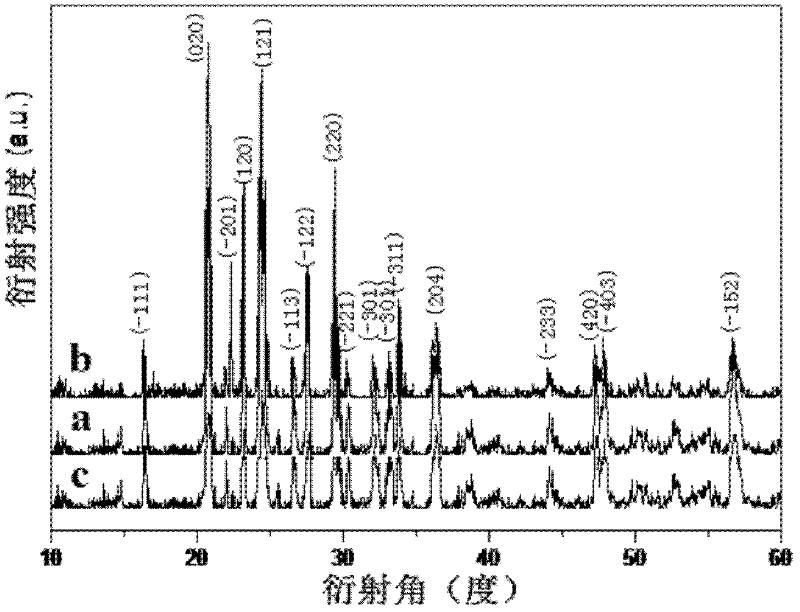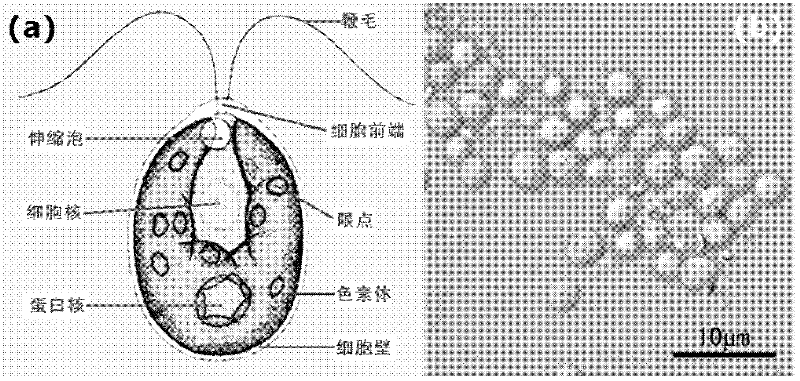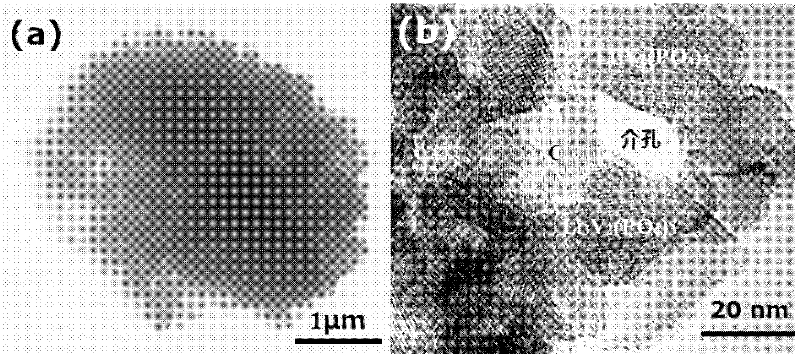Biomimetic synthesis method of lithium vanadium phosphate/carbon nanometer composite mesoporous microspheres as positive electrode material of lithium ion battery
A nano-composite, lithium vanadium phosphate technology, applied in battery electrodes, circuits, electrical components, etc., can solve the problems of low conductivity and conductivity of lithium vanadium phosphate
- Summary
- Abstract
- Description
- Claims
- Application Information
AI Technical Summary
Problems solved by technology
Method used
Image
Examples
Embodiment 1
[0041] Take 2ml of fresh green algae solution prepared by Chlorella (Chlorella) algae numbered FACHB-1227, put it in 50ml of distilled water, change the water once every 3h, and continuously starve for one day at 25°C to obtain starved green algae. Algae cell solution, the cell concentration in the control solution is 6.5×10 7 unit / ml, recorded as A solution.
[0042] Dissolve analytically pure vanadium pentoxide and oxalic acid in an aqueous solution at a molar ratio of 1:2, heat and stir in a water bath at 70°C for about 0.5 h to prepare a 1 mol / L vanadium ion solution, and obtain B solution.
[0043] According to the volume ratio of solution B: solution A = 1:2, solution B was added dropwise to solution A, and stirred thoroughly for 5 hours to obtain C sol solution.
[0044] According to Li 3 V 2 (PO 4 ) 3 Stoichiometric ratio, add 0.5 mol / L ammonium dihydrogen phosphate to the C sol solution, stir for 5 hours, then add 0.8 mol / L lithium nitrate (lithium source), and s...
Embodiment 2
[0046] As described in Example 1, the difference is that the lithium nitrate lithium source is replaced by lithium hydroxide, and other conditions are the same as in Example 1. The resulting black powder Li 3 V 2 (PO 4 ) 3 / C nanocomposite mesoporous microspheres, the products were analyzed by XRD, which showed that they were all monoclinic Li 3 V 2 (PO 4 ) 3 Complexes with C, such as figure 1 as shown in b. The bulk density of synthetic composite powder can reach 1.51g / cm 3 , the conductivity is 6.507×10 -3 S / cm, when the charge and discharge voltages are 3.0-4.3V and 3.0-4.8V respectively, the first discharge specific capacity at 0.1C rate can reach 124mAh / g and 183mAh / g respectively, and the discharge retention rate is 95% and 91% respectively. After 40 weeks of circulation, the specific capacities were 115mAh / g and 140mAh / g, and the retention rates were 88% and 76%, respectively.
Embodiment 3
[0048] As described in Example 1, the difference is that the lithium nitrate lithium source is replaced by lithium acetate, and other conditions are the same as in Example 1. The resulting black powder Li 3 V 2 (PO 4 ) 3 / C nanocomposite mesoporous microspheres, the products were analyzed by XRD, which showed that they were all monoclinic Li 3 V 2 (PO 4 ) 3 Complexes with C, such as figure 1 as shown in c. The bulk density of synthetic composite powder can reach 1.35g / cm 3 , the conductivity is 1.915×10 -4 S / cm, when the charge and discharge voltages are 3.0-4.3V and 3.0-4.8V respectively, the first discharge specific capacity at 0.1C rate can reach 104mAh / g and 173mAh / g respectively, and the discharge retention rate is 92% and 89% respectively. After 40 weeks of circulation, the specific capacities were 97mAh / g and 139mAh / g, and the retention rates were 86% and 75%, respectively.
PUM
| Property | Measurement | Unit |
|---|---|---|
| particle diameter | aaaaa | aaaaa |
| pore size | aaaaa | aaaaa |
| density | aaaaa | aaaaa |
Abstract
Description
Claims
Application Information
 Login to View More
Login to View More - R&D
- Intellectual Property
- Life Sciences
- Materials
- Tech Scout
- Unparalleled Data Quality
- Higher Quality Content
- 60% Fewer Hallucinations
Browse by: Latest US Patents, China's latest patents, Technical Efficacy Thesaurus, Application Domain, Technology Topic, Popular Technical Reports.
© 2025 PatSnap. All rights reserved.Legal|Privacy policy|Modern Slavery Act Transparency Statement|Sitemap|About US| Contact US: help@patsnap.com



